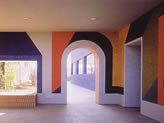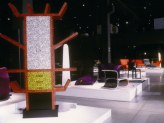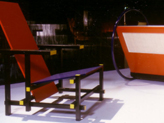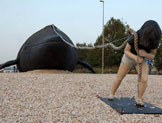Museo dell'Arredo Contemporaneo - Russi
S.S. San Vitale 48026 Russi
Tel. 0544 419299 - 338 9586837 Fax 0544 416119
email info@museoarredocontemporaneo.com
web http://www.museoarredocontemporaneo.com
il Museo è attualmente chiuso!
La collezione è stata trasferita a Milano nell'aprile 2015 ed è visitabile presso il Museo del Design 1880-1980
Nella seconda metà degli anni ottanta una commissione di esperti, tra cui Giovanni Klaus Koenig, Giuseppe Chigiotti e Filippo Alison, ha selezionato 150 pezzi di arredo che hanno costituito una prima esposizione permanente sulla storia del design dell'arredo dal 1880 al 1980.
Successivamente tale esposizione grazie alla buona scenografia e all'impianto esplicativo e didattico (curati da Piero Castiglioni) si è trasformato in un Museo che, suddiviso per sezioni, raffigura alcuni periodi storici. Inizia dall'Art Nouveau in Spagna (Anton Gaudi), in Austria (Michael Thonet), in Scozia e Inghilterra (Charles R. Mackintosh) e utilizza tavole luminose che riportano cenni biografici degli autori.
Si passa quindi alla grande scuola viennese del primo '900, la Wiener Werkstatte, alla quale aderirono molti artisti e architetti, tra cui Joseph Hoffman, Otto Wagner, Joseph M. Olbrich, col fine di creare opere d'arte complete nei dettagli e di prima qualità. Segue un'altra grande scuola tedesca, la Bauhaus, che diede un grande contributo alla cultura del design con Walter Gropius (fondatore e primo direttore), Marcel Breuer e Mies Van der Rohe. Si incontrano in questo settore anche opere di Frank L. Wright e Gerrit T. Rietveld, autori più o meno dello stesso periodo, ma appartenenti a culture diverse: entrambi comunque, impegnati in un programma di radicale rinnovamento artistico del primo Novecento.
E' la volta poi di Russia, Francia e Italia negli anni '30, con la presenza di quegli autori (tra cui Le Corbusier, i mobili del quale nascevano con la collaborazione di Charlotte Perriand e Pierre Jannert, Jean Prouvé, Giò Ponti, Giuseppe Terragni e Pietro Chiesa) che hanno maggiormente contribuito allo sviluppo del design.
Dopo la parentesi del movimento Decorative Arts inteso come arte decorativa alla ricerca del bello funzionale, elegante e non decadente, ecco l'Organic Modernism riferito agli anni '50 tipicamente scandinavi, americani e italiani, con nomi di spicco quali Alvar Aalto, uno dei padri dell'architettura organica; Charles Eames, uno dei più grandi designers americani; Giò Ponti, architetto ed artista, fondatore di Domus, una delle prime riviste di arredamento del mondo.
Si arriva così agli anni '60, durante i quali gli imprenditori italiani avviano il processo di industrializzazione del design, mettendo a punto nuove tecnologie per la produzione in serie dei mobili e degli oggetti di arredo. Per questo la sezione più nutrita del museo è quella dedicata alla grande produzione industriale, l'Industrial Design, che impegna le industrie italiane nella sperimentazione di nuovi materiali, e nella produzione in serie di arredi per la casa con caratteristiche nuove di estetica e funzionalità.E' il Made in Italy insomma, che tutto il mondo riconosce come stile italiano, e che continua durante gli anni '70, fino agli inizi degli '80, quando l'esposizione museale termina con alcuni esemplari di mobili tedeschi e giapponesi il cui design si impone per forma e funzione.
Tra i molti esponenti italiani di quest'ultimo periodo emergono Achille e Pier Giacomo Castiglioni, Carlo Scarpa, Gae Aulenti, Marco Zanuso, Gaetano Pesce, Afra e Tobia Scarpa, Ettore_Sottsass, Giancarlo Piretti, Vico Magistretti. I pannelli perimetrali descrivono questo periodo che va dal 1880 al 1980, suddiviso in sei momenti che si susseguono e si compenetrano fra loro. Ognuno di questi pannelli raffigura diverse immagini riferite all'epoca descritta: pittura, grafica, architettura, arti applicate, cinema, moda. A queste immagini si sovrappongono quelle dei pezzi prescelti; in questo modo il visitatore riesce a collegare immediatamente alcuni brani di storia.
° ° ° ° ° ° ° ° ° ° ° ° ° °° ° ° ° ° °° ° ° ° °° ° ° °° ° ° °° ° °° ° ° °° ° °° °° °° ° °° °
The Contemporary Furniture Museum was conceived by Raffaello Biagetti in 1980.
Biagetti began as a painter, later branching into furnishing and interior design in the Seventies, a passion that would lead him to collect, seek out and experience extraordinary situations.
In the second half of the Eighties was formed a committee, which included Giovanni Klaus Koenig and Giuseppe Chigiotti, both lecturers at the faculty of architecture and design in Florence, as well as Filippo Alison, a lecturer at the architecture and design faculty in Naples. This committee selected 150 works of design, which constituted a first permanent exhibition about the history of the interior design from 1880 and 1980.
The Museum was designed by Antonio Tubaro -pupil of Albe Steiner- with the contribution of Filippo Alison, who designed also the large gates, which he used to call "a big Cenobitic railing",
that surround the Museum grounds.
Finally Biagetti asked Piero Castiglioni to come up with a special lighting project for this huge installation.
In the 1990's architects Ettore Sottsass and Johanna Grawunder designed a blue architectural structure covering 600 square metres which, by literally attaching itself to the Museum, greatly expanded the real and ideal scope of the venue, envisaging the space as an experimental campus for artists, school and the public.
Among the interior designers on show at the Museum, you can find:
- The Shakers: one of their principles was self-sufficiency. They believed that all forms of luxury
for its own sake were sinful, so their furniture embodies the original concept of "functionalism".
- Antoni Gaudì: the great Spanish artist and architect is represented here by the Calvet chair and
mirror. Nature provided the most important reference point for Gaudì and if you look at those
objects, you can easily make out the most incredible natural shapes, such as leaves and animal
paws.
- Charles Rennie Mackintosh: the Glasgow-born designer is renowned worldwide for his
innovative style, which contributed to the birth of Art Nouveau. His furniture combined an
extreme harmony of form and a certain majesty.
- Frank Lloyd Wright: he is one of the chief exponents of the architectural Modern Movement and
the leading representative of organic architecture.
- Walter Gropius: he was the founder and first director of Bauhaus school, believing there was no
differences between pure and applied art, or between "high" and "low" art.
- Marcel Breuer: he designed many pieces of furniture during his years of working at the Bauhaus,
including the famous "Wassily" chair, dedicated to the painter Wassily Kandinsky.
- Le Corbusier: he designed his first house at the tender age of eighteen. His architecture conveys a
sense of lightness, with an open floor plan, long strips of ribbon windows and roof garden.
- Alvar Aalto: an expert in industrial design and public building, in 1929, he began to experiment
with the possibility of moulding wood.
- Giò Ponti: architect, inventor and poet, he focused his attention not only on architecture, but also
on furniture design, furnishing, machines, lamps, fabrics, pottery and others. His "Superleggera"
chair, which is on show at the Museum, is made entirely of natural materials.
- Carlo Scarpa: he was a sculptor, designer and artist and with his rational, romantic control,
resisted all other contemporary movements and trends.
- Bruno Munari: he was one of the greatest figures in art, industrial and graphic design of the
Twentieth century. Important his research into the subjects of movement, light and the
development of creativity and imagination in childhood through play. One good example is the
"Abitacolo", a multi-functional children bed designed in 1970.
- Alessandro Mendini: he focused on the creation of objects for pure artistic pleasure, outside of
industrial production and their practical use. The Museum houses one of his works: "Proust", a
hand-painted armchair, which is a tribute to the French writer Marcel Proust.




